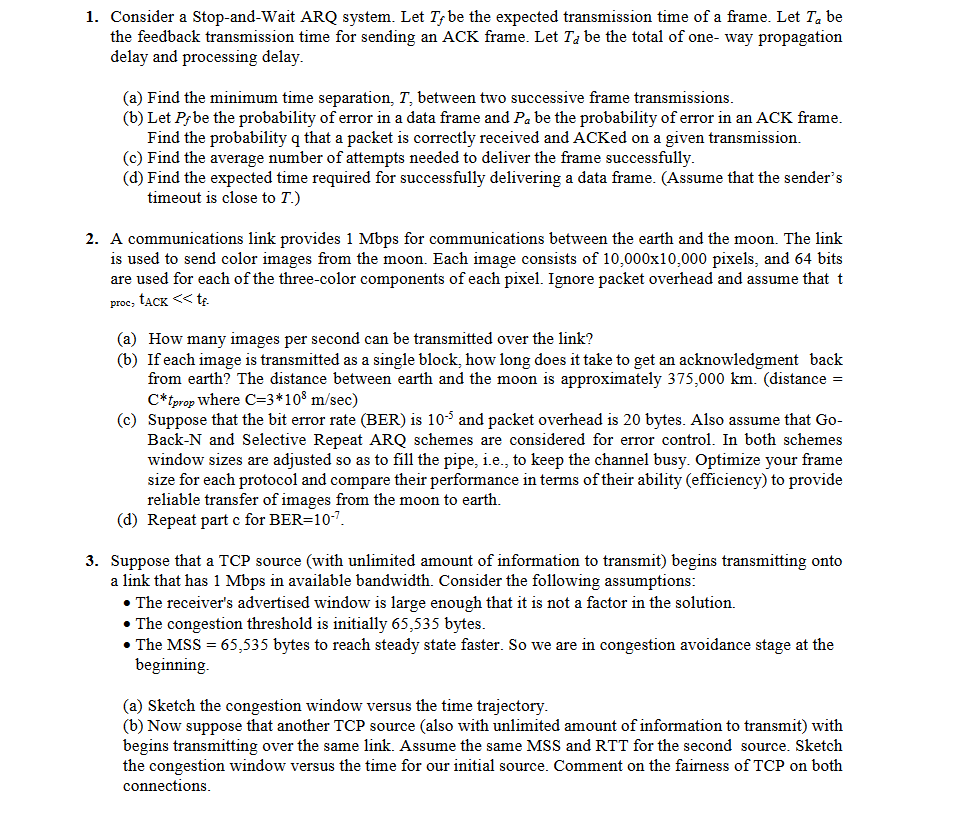
1. Consider a Stop-and-Wait ARQ system. Let Tf be the expected transmission time of a frame. Let Ta be the feedback transmission time for sending an ACK frame. Let Td be the total of one- way propagatiorn delay and processing delay (a) Find the minimum time separation, T, between two successive frame transmissions (b) Let Pfbe the probability of error in a data frame and Pa be the probability of error in an ACK frame Find the probability q that a packet is correctly received and ACKed on a given transmissiorn. (c) Find the average number of attempts needed to deliver the frame successfully (d) Find the expected time required for successfully delivering a data frame. (Assume that the sender's timeout is close to T.) 2. A communications link provides 1 Mbps for communications between the earth and the moon. The link is used to send color images from the moon. Each image consists of 10,000x10,000 pixels, and 64 bits are used for each of the three-color components of each pixel. Ignore packet overhead and assume that t proc LACK (a) How many images per second can be transmitted over the link? (b) If each image is transmitted as a single block, how long does it take to get an acknowledgment back from earth? The distance between earth and the moon is approximately 375,000 km. (distance C*tprop where C 3*108 m/sec) (c) Suppose that the bit error rate (BER) is 10- and packet overhead is 20 bytes. Also assume that Go- Back-N and Selective Repeat ARQ schemes are considered for error control. In both schemes window sizes are adjusted so as to fill the pipe, i.e., to keep the channel busy. Optimize your frame size for each protocol and compare their performance in terms of their ability (efficiency) to provide reliable transfer of images from the moon to earth. (d) Repeat part c for BER-10- 3. Suppose that a TCP source (with unlimited amount of information to transmit) begins transmitting onto a link that has 1 Mbps in available bandwidth. Consider the following assumptions The receiver's advertised window is large enough that it is not a factor in the solution. The congestion threshold is initially 65,535 bytes The MSS 65,535 bytes to reach steady state faster. So we are in congestion avoidance stage at the beginning (a) Sketch the congestion window versus the time trajectory (b) Now suppose that another TCP source (also with unlimited amount of information to transmit) with begins transmitting over the same link. Assume the same MSS and RTT for the second source. Sketch the congestion window versus the time for our initial source. Comment on the fairness of TCP on both connections 1. Consider a Stop-and-Wait ARQ system. Let Tf be the expected transmission time of a frame. Let Ta be the feedback transmission time for sending an ACK frame. Let Td be the total of one- way propagatiorn delay and processing delay (a) Find the minimum time separation, T, between two successive frame transmissions (b) Let Pfbe the probability of error in a data frame and Pa be the probability of error in an ACK frame Find the probability q that a packet is correctly received and ACKed on a given transmissiorn. (c) Find the average number of attempts needed to deliver the frame successfully (d) Find the expected time required for successfully delivering a data frame. (Assume that the sender's timeout is close to T.) 2. A communications link provides 1 Mbps for communications between the earth and the moon. The link is used to send color images from the moon. Each image consists of 10,000x10,000 pixels, and 64 bits are used for each of the three-color components of each pixel. Ignore packet overhead and assume that t proc LACK (a) How many images per second can be transmitted over the link? (b) If each image is transmitted as a single block, how long does it take to get an acknowledgment back from earth? The distance between earth and the moon is approximately 375,000 km. (distance C*tprop where C 3*108 m/sec) (c) Suppose that the bit error rate (BER) is 10- and packet overhead is 20 bytes. Also assume that Go- Back-N and Selective Repeat ARQ schemes are considered for error control. In both schemes window sizes are adjusted so as to fill the pipe, i.e., to keep the channel busy. Optimize your frame size for each protocol and compare their performance in terms of their ability (efficiency) to provide reliable transfer of images from the moon to earth. (d) Repeat part c for BER-10- 3. Suppose that a TCP source (with unlimited amount of information to transmit) begins transmitting onto a link that has 1 Mbps in available bandwidth. Consider the following assumptions The receiver's advertised window is large enough that it is not a factor in the solution. The congestion threshold is initially 65,535 bytes The MSS 65,535 bytes to reach steady state faster. So we are in congestion avoidance stage at the beginning (a) Sketch the congestion window versus the time trajectory (b) Now suppose that another TCP source (also with unlimited amount of information to transmit) with begins transmitting over the same link. Assume the same MSS and RTT for the second source. Sketch the congestion window versus the time for our initial source. Comment on the fairness of TCP on both connections







